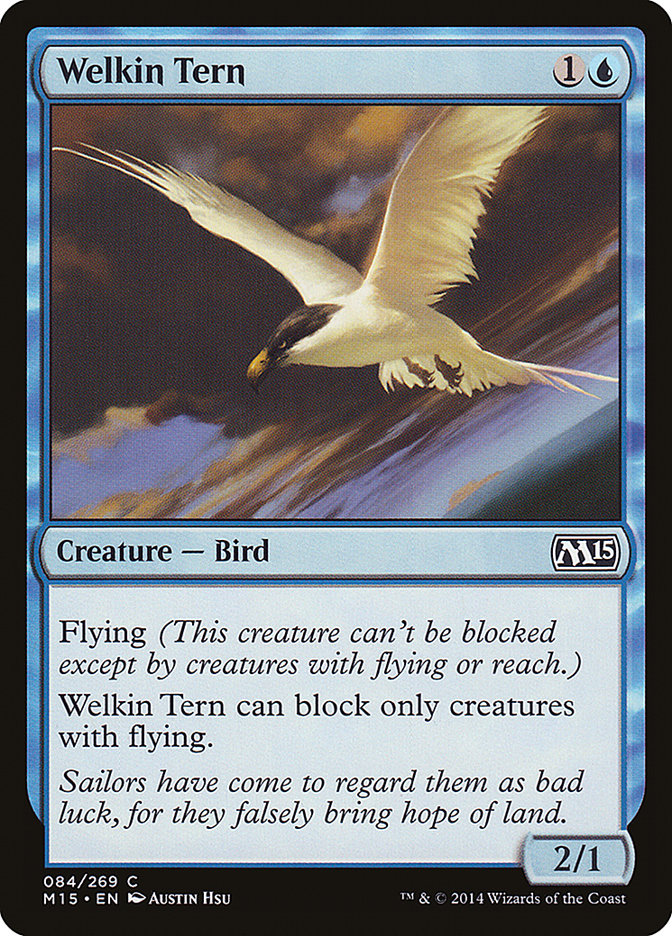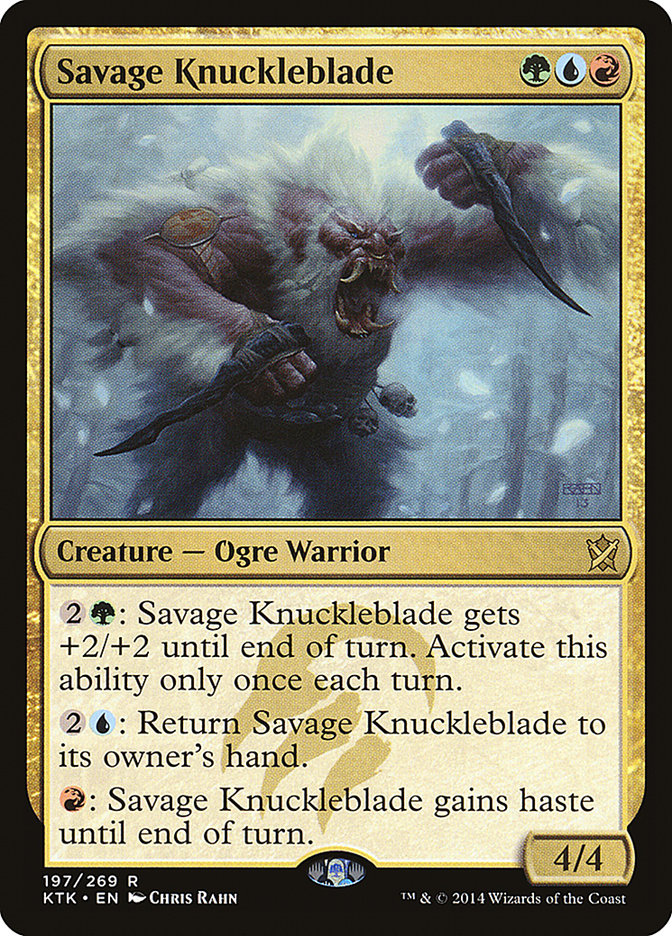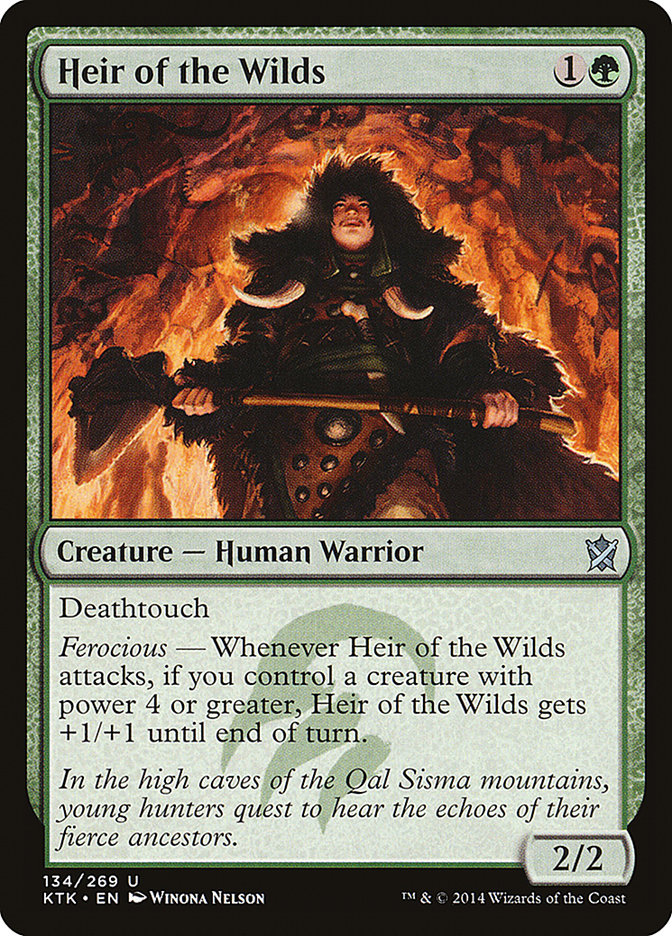Over the last month, I have been asked numerous times about how disappointed I must feel that my beloved Mono-Blue Devotion deck is rotating out of
Standard. While there is no doubt that I have experienced some of my greatest success piloting that deck over much of this year and as such I have enjoyed
this format more than most, the stale repetitiveness of Return to Ravnica-Theros Standard wore me down over the summer, and I am excited to pilot something
new this fall.
Writing biweekly, I have fewer opportunities to offer my thoughts on Khans of Tarkir, so I really wanted to take advantage this week with the full spoiler
and give some insight into what I am thinking about playing for the dual Open Series weekend in New Jersey at the end of this month.
Well there is one tiny problem with that plan:
I don’t have a clue what to do!
Every deck I tried to brew looked obvious or awful. And not awful in the “this is a new format and this deck full of good cards needs significant tuning”
kind of way. Awful in the “this deck has serious theoretical flaws in curve, mana, power level, or any combination thereof” kind of way.
Typically, when I am lost, I enter data-gathering mode. Step one is to read everything I can. Step two is to bother everyone I know on social media and
whine at them until they give me all their secrets. Essentially I want to collect the widest swath of opinions possible and try and synthesize that
information into a reasonable picture of the early format. As it turns out the swath of opinions about this format is not particularly wide.
There are people that like the low-curve aggressive decks, which have 18-22 Mountains or Swamps, a pile of the best cheap creatures, and appropriate
removal/burn spells. There is no fluff here. Simple, efficient, brutal is the name of the game. Honestly, the card choices in these decks are largely
interchangeable, so I will not focus much on them past their status as the pace setters of the format.
Others are convinced that the often discussed Sylvan Caryatid/Courser of Kruphix shell from Block is poised to dominate Standard to a dangerously
oppressive degree. This pair of green creatures is an excellent base to midrange strategies since they play well against any type of deck, fix your mana
and draws, and leave you open to almost any card in the format should the need arise. The control decks do not have access to anything remotely close to
Sphinx’s Revelation to dominate the late-game, so they will likely be forced to fight the midrange decks in their own haymaker game. When each player has
the tools to turn a game around in a single turn, it is important to put your opponent behind and never open a window of opportunity for them to land their
own threat. Caryatid ensures that you will get your threat down first, and Courser helps to dig for more to keep the pressure on.
Unfortunately, there was not much going on past these initial ideas. There are plenty of exciting cards in Khans of Tarkir, certainly enough to build a
reasonable deck in any of the wedges. But I did not like most of the cheap cards in Jeskai or Mardu, and when I brewed with any of the green wedges, my
deck invariably turned into a Courser/Caryatid deck. Did I mention that those cards are really good? I hope no one else has figured that out.
I have a decklist with Vaporkin and Welkin Tern. I am not proud of this.
As I spent more and more hours scribbling decks that looked terrible, a growing pessimism came over me. Nothing seemed equipped to fight Goblin
Rabblemaster and Courser of Kruphix. Of course, history has shown that formats are never so obvious. Return to Ravnica-Theros Standard was an anomaly in
how quickly the top decks were found, but Mono-Black Devotion was still a complete unknown to most of the participants in the Pro Tour. The year before
Sphinx’s Revelation flew under the radar while people were fiddling around with Miracles and Lotleth Troll. There is definitely something I am missing, but
luckily searching for it is the fun part.
The key to brewing for a new format is ignoring everything you learned from the outgoing one. Taking the above examples, Lotleth Troll was viewed as the
two drop that Delver era Zombies was always lacking. With the core of that deck remaining intact, B/G Zombies was poised to be a powerhouse in Return to
Ravnica Standard. But the tools for fighting Delver of Secrets and Geist of Saint Traft were ineffective against Thragtusk and Augur of Bolas.
The “Zombies” deck that ended up performing in that format was really a haymaker aggro deck that used Gravecrawler and Diregraf Ghoul to divert the
opponent’s resources long enough to land a Falkenrath Aristocrat or Thundermaw Hellkite that would win the game by itself. Since the deck was centered on
leveraging the power of the heavy hitters, G/R Aggro with Elvish Mystic and Arbor Elf to accelerate into large threats supplanted Zombies as a more
strategically sound shell.
So when approaching a new format, avoid the temptation to look at what previous decks are gaining and losing. Those decks are completely irrelevant. The
new format should be treated as such, and so you would be better served by building decks from scratch. With that said, my goal is always to build
proactive decks, simply because I prefer those strategies from a gameplay perspective and am more comfortable building and piloting them. If the shell for
a good reactive deck presents itself, I will certainly consider it (I played U/B Control at Grand Prix: Baltimore in 2012 and U/W Control at the end of
Innistrad-Return to Ravnica Standard), but until I build a more well-rounded game, I will stick to writing about what I know.
As I mentioned above, my brews with any of the green wedges always seemed to turn into a Caryatid/Courser deck. However, both Abzan and Temur offer some
hope to be aggressive and match up well against the green midrange menace since they have impressive 4/4s for three mana in Anafenza, the Foremost and
Savage Knuckleblade. These decks are caught in an awkward scenario with their mana though. There are plenty of dual lands available in Khans Standard, but
they all require you to sacrifice tempo (Temples, Tri-lands) or life (Painlands, Fetchlands, Mana Confluence). The former means that even though our
creatures may match up well against Caryatid and Courser, they may not come down fast enough to beat the midrange haymakers. The latter means that we are
going to be sacrificing significant percentages against the small aggro decks. For example, look at this prospective brew of an Abzan aggro deck:
Creatures (22)
- 4 Polukranos, World Eater
- 4 Fleecemane Lion
- 4 Herald of Torment
- 2 Heir of the Wilds
- 4 Anafenza, the Foremost
- 4 Rakshasa Deathdealer
Planeswalkers (1)
Lands (25)
Spells (12)

In the interest of full disclosure, this deck is completely untested, but I think it effectively demonstrates the difficulty of beating the two expected
classes of decks for the early Khans Standard format. But first, I will look at some of the advantages that led me to this shell.
One of the first issues I had when trying to build aggressive decks for this format was that there are very few good two-drops, and even fewer that compare
favorably with Sylvan Caryatid. The Abzan wedge gains access to the best of them in Fleecemane Lion and a pair of solid newcomers in Rakshasa Deathdealer
and Heir of the Wilds. Rakshasa is reasonably costed, attacks profitably into Courser and Caryatid, and provides a great mana sink for longer games. Having
mana sinks in these higher curve aggressive decks is incredibly important since we lack any sort of utility land, and the increased curve and more
stringent color requirements will require an increased land count. You will notice a robust 25 lands in the above list, and I would never consider anything
fewer than 24. With the additional mana sinks of Fleecemane Lion, Polukranos, and Herald of Torment I prefer to err on the higher side with 25.
Heir of the Wilds is on my shortlist of most underappreciated cards in the set. It is easy to cast (an underrated ability in a format of gold cards),
attacks into almost everything, and every creature in the deck has at least four power or can make a creature with more than four power. Heir is going to
be very close to Wren’s Run Vanquisher in this deck, a card that fueled aggressive starts for the very successful Elf decks in Lorwyn era Standard. I would
not be surprised to see that card overperform in testing and play its way to four slots, much like Daring Skyjek did last fall.
Moving on, the disruption suite Abzan offers is excellent, and gives this deck the tools to answer any threat from the opposition. The downside of this is
that they all cost three, leading to an inflated curve. The lack of good plays for two mana and glut of them at three is the biggest issue I see in this
Standard format. All of the Charms are solid cards, but trying to play them alongside the unconditional removal of Banishing Light and Hero’s Downfall is
incredibly difficult. I am expecting to see many frustrated players lose games while being unable to deploy their cards in a timely manner. Remember that
it is important to reach a point in the game where you can start playing two cards in one turn as well as cast your cheap cards on time.
I have done my best to mitigate that by including plenty of two-drops, allowing multiple spells to be cast on turn 4 or 5 with reasonable consistency.
Also, I chose Herald of Torment because it functions very well as a curve-topper that effectively breaks stalemates. This way I was able to avoid playing
more expensive spells with a curve that is inflated in the middle.
Clearly this deck was devised with green midrange decks in mind, but as I noted earlier, that leaves it particularly vulnerable to the small aggro decks.
This deck is curved to not fall too far behind, but the inconsistency of a three color manabase along with eight Temples is going to create a fair share of
stumbles. Moreover, the manabase contains nine painlands and three fetchlands to go along with Thoughtseize, Abzan Charm, and Herald of Torment-ambitious
to say the least. Sorin, Solemn Visitor earned a slot to give the deck some way to gain back life and should likely appear in higher numbers. Similarly,
the second Urborg, Tomb of Yawgmoth helps reduce the damage done by our lands, but I highly doubt it is enough. One thing I am going to miss is playing
twenty basic lands.
Fortunately, solving the issue of linear aggro decks is easily doable as long as we are dedicated enough, and I think there are some excellent tools. My
plan would be to morph into a midrange deck, using something like Nyx-Fleece Ram as an early blocker to set up a better board and land a back-breaking
Sorin. Crippling Blight or Oppressive Rays can serve as reasonable cheap removal to not fall behind and reach those precious double spell turns as early as
possible. The latter is particularly good against Bloodsoaked Champion. If sweepers are necessary, then Drown in Sorrow only kills six creatures in the
deck and Festergloom does not kill any.
There is certainly much tuning to be done with this deck, but I think it falls safely into the fixable category of awful as opposed to the irrevocably
flawed category. It is very possible that this deck falls into the same category as the various Naya decks that were popular choices going into Pro Tour
Theros. Those decks looked good on paper although with shaky mana. They had a reasonable curve, powerful creatures like Boros Reckoner and Stormbreath
Dragon, and some solid interactive spells like Mizzium Mortars, but they were crushed by the synergy inherent in the devotion decks and raw power of
Sphinx’s Revelation.
The synergy decks always seem obvious once they are revealed but are surprisingly difficult to find, which is why you see so many people have success with
fundamentally sound, but somewhat bland strategies in the early weeks. Not only have few people found the top decks, but those that have tried and failed
will be easy to beat with a sound if unexciting deck.
Note that I make this claim irrespective of the macro-archetype in question. It is commonly said that aggressive decks are better positioned early on in a
format, but I disagree in the abstract. The early tournaments will be filled with mono-colored aggro decks, various Courser/Caryatid decks, and some
wedge-colored brews. Even if all of these strategies end up being obsolete in the coming months, the hype around them creates a self-fulfilling prophecy.
It should not be hard for a dedicated control player to build to such a metagame and find success, even in a short amount of time. The key is that the
successful decks are sticking to powerful cards, workable mana, and a fine curve. It is basic, fundamental decks that have the edge in early formats, not
necessarily aggro or control.
So what are we to do if we want to break from the norm and find the new breakout deck? I cannot know for certain since I have never had the fortune of
finding such a deck, but it seems to me that there has been a common thread in successful decks at the Pro Level: mana. The best decks early in a format,
and frequently after that, are able to consistently generate a huge mana advantage or take advantage of new lands to create a new archetype that preys on
the established metagame.
At
Pro Tour Theros
, it was leveraging the power of Nykthos and Mutavault. At
Pro Tour Gatecrash
, it was using the new shocklands to create unforeseen archetypes, which also happened at the first
Pro Tour Honolulu
following the release of Guildpact. Even Caw-Blade, perhaps the most memorable Pro Tour deck of all time, was built around the incredible mana advantage
generated by Stoneforge Mystic and Sword of Feast and Famine.
Creatures (8)
Planeswalkers (7)
Lands (17)
Spells (28)
- 4 Plains
- 5 Island
- 3 Mana Leak
- 4 Day of Judgment
- 4 Spell Pierce
- 1 Deprive
- 4 Preordain
- 1 Stoic Rebuttal
- 1 Sylvok Lifestaff
- 1 Sword of Feast and Famine
Sideboard

For this format, the obvious way to break the mana parity is by playing Green. Elvish Mystic, Rattleclaw Mystic, and Sylvan Caryatid provide an excellent
base of acceleration and fixing in a slow, multicolored format. Combined with Courser of Kruphix, Green has built-in defense against the small aggro decks.
Perhaps I should just give up and join the hoard of players looking to find the best green deck. But I am stubborn. While I may often take the obvious path
and play a tier one deck for an entire format, early on I like to explore my options. The key question is how to outpace the green decks. Maybe a twist on
some old technology will do it:
Creatures (24)
- 2 Heliod, God of the Sun
- 4 Soldier of the Pantheon
- 2 Ephara, God of the Polis
- 4 Brimaz, King of Oreskos
- 4 Vanguard of Brimaz
- 4 Eidolon of Countless Battles
- 4 Wingmate Roc
Planeswalkers (4)
Lands (25)
Spells (7)

This deck can generate some huge boards. It is on the slow side and does not have much interaction, but the buttery smooth mana will help mitigate that.
Maybe it needs more mana sinks like Soul of Theros or Avacyn, Guardian Angel, and maybe it needs more token generators to take advantage of the anthems.
Raise the Alarm, while underpowered on its own and not providing any devotion, can easily make 2/2s or better in this deck and provides another great
defensive option against the bevy of one mana 2/1s in the format. As an instant, it also has some synergy with Ephara.
In all likelihood, the decks I have presented here will not be viable tournament options. As any long time player will tell you, the vast majority of brews
are terrible. Maybe one of these decks will be good in New Jersey but quickly outclassed by the real top decks in the format. Whenever I brew I seem to
have a feeling of hopeful pessimism. Like everyone else, most of my decks are terrible, and I have grown to expect the same. But all it takes is one
success to make all the failures worth it. So good luck to everyone trying out new and exciting decks. Hopefully this article gave you some insight in how
to direct your deckbuilding towards more constructive ends. See you in New Jersey!




